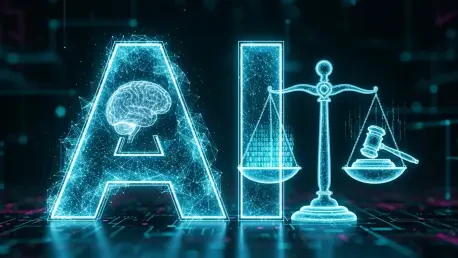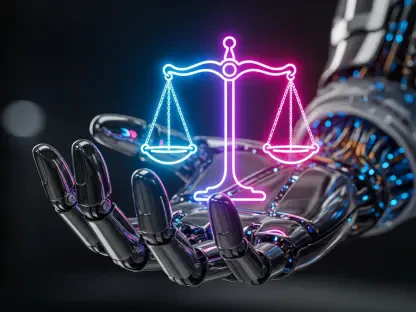In the heart of a bustling London courtroom, a legal team sifts through thousands of documents for a high-stakes case, a process that once took weeks but is now condensed into mere hours thanks to artificial intelligence (AI). This remarkable shift exemplifies how AI is revolutionizing the legal sector, tackling inefficiencies in a field long burdened by paperwork and repetitive tasks. As AI tools become integral to law firms and judicial processes, their potential to transform justice delivery sparks both excitement and concern, prompting a deeper look into their capabilities and challenges within the UK legal landscape and beyond.
Core Features of AI in Legal Technology
Automating Research and Document Analysis
AI’s standout feature in the legal domain lies in its ability to automate research and analyze vast troves of legal texts with unprecedented speed. Leveraging machine learning and natural language processing, large language models (LLMs) can sift through case law, statutes, and legal precedents to extract pertinent information, often summarizing complex documents in minutes. This functionality significantly reduces the time lawyers spend on monotonous tasks, allowing them to focus on strategic aspects of their cases.The performance of these tools in real-world settings has shown impressive results, with many law firms reporting a sharp decline in research hours. However, the accuracy of AI outputs often hinges on the quality of the data it processes, raising questions about reliability when dealing with niche or evolving legal areas. This balance of speed versus precision remains a critical point of evaluation for legal professionals adopting such systems.
Streamlining Contract Drafting and Review
Another pivotal feature of AI in legal practice is its capacity to draft and review contracts with efficiency. Specialized tools can generate standardized agreements by pulling from vast databases of legal templates, ensuring compliance with current regulations while minimizing human error. This automation proves invaluable for corporate legal departments managing high volumes of contracts under tight deadlines.Despite these advantages, AI-driven drafting tools struggle to capture nuanced intent or context-specific requirements without human input. Legal documents often carry subtleties that require a deep understanding of client needs, an area where technology falls short. Thus, while AI enhances productivity, it necessitates careful oversight to ensure the final output aligns with specific case demands.
Performance and Real-World Impact
AI’s integration into legal systems has yielded tangible benefits across diverse applications, from law firms using it for case analysis to corporations employing it for contract management. Specialized platforms, such as those developed by LexisNexis, have gained traction for their tailored approach, offering more reliable outputs compared to general-purpose AI tools. These implementations have led to notable efficiency gains, with some firms reporting up to a 50% reduction in time spent on preliminary casework.High-profile use cases, such as AI-assisted dispute resolution platforms, further highlight the technology’s potential to streamline processes. Yet, performance is not without flaws, as evidenced by recent UK incidents where AI misuse resulted in errors like fabricated case citations in court submissions. These missteps underscore the technology’s limitations when not paired with rigorous verification, pointing to a gap between capability and practical reliability.The broader impact on judicial processes also raises concerns about accessibility and trust. While AI can democratize legal services by reducing costs, over-reliance risks undermining public confidence if errors persist. Balancing these performance benefits with systemic integrity remains a pressing challenge for stakeholders in the legal field.
Challenges and Limitations in Deployment
One of the most significant hurdles for AI in legal systems is its technical dependency on static or outdated data, which can skew results in a field where laws and precedents evolve rapidly. Unlike human judgment, which adapts to cultural and societal shifts, AI often operates on fixed datasets, limiting its applicability in dynamic legal contexts. This constraint poses risks in long-term use, especially for predictive analytics or case outcome forecasting.Ethical and regulatory challenges compound these technical issues, with misuse cases highlighting the potential for AI to erode trust in justice systems. Instances of lawyers citing fictitious cases due to unverified AI outputs have prompted senior judicial figures to warn of serious implications, including legal consequences for professionals who fail to double-check results. Developing robust verification protocols and training programs is essential to address these gaps.Beyond technical and ethical concerns, AI lacks the human qualities of empathy and insight, which are critical for judicial decision-making. While it can process data at scale, it cannot replicate the emotional intelligence required for rulings that often serve as a last resort. This limitation reinforces the consensus that AI should remain a supportive tool rather than a replacement for human oversight in sensitive legal matters.
Summing Up the Review
Reflecting on the exploration of AI in legal systems, it becomes evident that the technology offers transformative benefits by enhancing efficiency and reducing workload for legal professionals. Its features, from automating research to streamlining contract drafting, demonstrate substantial potential to modernize a traditionally slow-moving sector. However, the journey also reveals critical shortcomings, with errors from misuse and inherent limitations in empathy casting a shadow over unchecked adoption.Looking ahead, the path forward demands a focus on actionable safeguards to ensure responsible integration. Developing stricter verification processes and comprehensive training for legal practitioners emerges as an immediate priority to prevent errors that could compromise justice. Additionally, policymakers need to craft regulatory frameworks that encourage innovation while protecting systemic integrity, ensuring AI serves as a reliable ally rather than a risky shortcut in the pursuit of fair legal outcomes.









